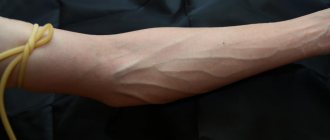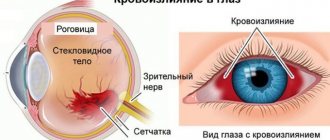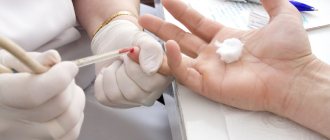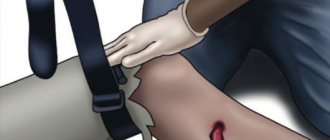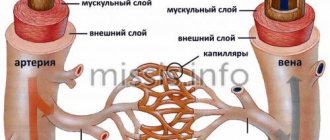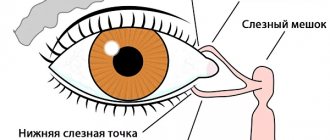Main causes of pathology
The capillary network in its structure has arterioles, precapillaries and venules. Capillaries can burst on the body for the following reasons:
- weakness of the capillary wall;
- excessive load on the lower limbs;
- thrombocytopenia;
- hypothermia;
- skin hypersensitivity;
- excess weight;
- cirrhosis of the liver;
- injury;
- diseases of the cardiovascular system;
- vegetative-vascular dystonia;
- exposure to chemicals;
- disturbances in the functioning of the endocrine gland.
Most often, the cause is the individual predisposition of the body, as well as thinning of the capillary wall, due to which it cannot withstand pressure. People suffering from hypertension should regularly examine their body for bleeding on the skin. Bursted capillaries indicate a surge in pressure that went unnoticed. In such patients, the vascular bed has pathological fragility, which can react when the weather changes. Women during pregnancy, childbirth, abortion, hormonal therapy complain that capillaries burst. Basically, when hormonal levels change, such a pathology does not pose a great danger to life and health, but can cause discomfort.
A person with a history of heart attack, stroke or vegetative-vascular dystonia is more prone to fragility of the vascular wall than others.
Return to contents
Why do blood vessels in the eyes often burst due to overwork?
Ophthalmologists are sounding the alarm that there are more and more people with poor vision in the world. At the same time, visual pathologies become “younger.” Refractive defects are increasingly being diagnosed in minors, including very young children (preschoolers and primary school students). This is due to the use of electronic devices - phones, computers, tablets. Because of them, a person’s eyes are in constant tension. At the same time, few people do special gymnastics to relax the eye muscles. The vessels cannot withstand the stress and burst. Lack of visual hygiene can subsequently lead to visual deterioration.
Diagnostic methods
To independently check blood vessels for fragility, it is enough to carry out the following tests:
To check the fragility of blood vessels, you can use a tonometer cuff.
- Pinch. Under the clavicle bone, take the skin with two fingers and twist clockwise. If a hematoma or bruise forms, it means that there is thinning of the vessel wall.
- Drag. Inflate the blood pressure cuff by placing it on your forearm and leave for 10 minutes. After time has passed, remove the tourniquet and if red dots appear on the skin, this indicates damage to the capillaries. The patient needs to see a doctor immediately.
- Hammer. The patient's chest is lightly tapped with a hammer; if bruising occurs, the diagnosis of capillary wall weakness is confirmed.
A laboratory diagnostic method is the examination of blood vessels with a special apparatus - a capillaroscope. It is a microscope with a video camera and a monitor, on which the doctor can detect pathology in the integrity of the wall and subsequently prescribe treatment. The patient is recommended to undergo blood and urine tests to determine the general condition of the body.
Return to contents
What to do if blood vessels burst in the eyes?
So, you are unlikely to be able to determine exactly why a vessel in the eye burst. There are too many factors that can trigger this problem.
If your eyes turn red for the first time, most likely this is not associated with illness. In this case, redness can be eliminated using eye drops with a relaxing or moisturizing effect. Choose drugs based on “artificial tears” or sodium hyaluronate. If the redness does not go away, visit your doctor.
Risk factors
Causes of vascular fragility:
- Weakness of the walls of veins and capillaries, disruption of their permeability.
- Vessels in the legs burst due to prolonged stress on them.
- Common causes of ruptured blood vessels are pregnancy, childbirth, the use of oral contraception, abortion, ovarian cysts, fibroids, menopause and other phenomena that cause hormonal imbalance.
- Endocrine disorders in women.
- Poor nutrition.
- Physical inactivity.
- Bad habits.
- Skin damage caused by chemical peels, regular visits to the solarium, frostbite, burns.
- If a vein in the leg bursts, this is a sign of the initial stage of varicose veins.
- Fragile blood vessels can be a consequence of heavy training (the result of changes in blood pressure).
- Infections and viruses weaken the walls of blood vessels. After the underlying disease is treated, the burst capillaries disappear on their own.
- Systemic pathologies can contribute to the fragility of blood vessels in the fingers and toes: diabetes mellitus, obesity, coronary artery disease, angina pectoris, atherosclerosis, hypertension.
- Allergies can also cause the problem. So, when blood vessels on the hands burst, this may be a reaction to household chemicals.
- A lack of vitamins P and C in the body can cause increased fragility of the walls of capillaries and veins. In this case, the following symptoms occur: chills, the skin on the fingers and toes may turn blue. Hematomas due to deficiency of ascorbic acid and rutin form in autumn and winter.
Symptomatic treatment helps eliminate vascular fragility (it is carried out in a hospital and at home). True, when blood vessels burst in the hands due to a systemic disease, for example, hormonal imbalance, they will be damaged again.
The risk group includes people with sedentary jobs (drivers, teachers, office employees). Representatives of these professions are recommended to do a warm-up at least once every two hours - walk around the room, perform rotational movements with their arms, do several bends back, forward and to the sides.
Removing broken capillaries on the face
In response to the question of what to do if capillaries burst, most experts advise resorting to laser exposure or undergoing a course of mesotherapy. These techniques are universal and effective, and at the same time have a number of positive properties for the skin.
Laser removal
Laser treatment allows you to eliminate small capillaries in just one session. The beam energy acts on the injured vessel without damaging the surrounding tissue, so the procedure is absolutely safe.
Laser removal of capillaries is carried out as follows:
- The cosmetologist cleans the client’s face, puts on protective glasses, and applies a special gel to the treatment area. This minimizes discomfort and also protects against burns.
- After setting up the device, laser coagulation is performed.
- At the end of the session, a protective agent is applied, and the patient is given recommendations regarding the recovery period after the procedure.
In total, the session usually takes no more than half an hour. After it, for 2-3 weeks it is important to carefully protect the skin from exposure to ultraviolet radiation and temperature changes. Among the contraindications to laser coagulation of blood vessels:
- diabetes;
- neoplasms;
- acute diseases with skin manifestations;
- period of pregnancy and breastfeeding.
Signs and diagnosis
To establish the degree of vascular damage, the following techniques are used:
- Treatment of cerebral vessels: folk remedies, traditional medicine
- Pinch method: The fold of skin in the chest area should be pinched between the middle and index fingers. Accidental damage is excluded in this area, and pressure on the skin does not cause pain. If after the manipulations a hemorrhagic spot has formed on the tested area, the fragility of the blood vessels is significant.
- Tap the skin in the chest area with a hammer. If hematomas appear after this, the walls of the vessels are weakened.
- Tourniquet method. The middle part of the shoulder is rewound with a tourniquet so that the outflow of venous blood is stopped and arterial blood is not disturbed. If, after removing the tourniquet, petechiae have formed in the area being examined, the degree of vascular fragility is high, and the patient requires medication therapy.
When diagnosing problems with blood vessels, you need to pay attention to the following symptoms:
- Dizziness.
- The appearance of “stars” or black dots before the eyes with a sudden change in body position.
- Even minor injuries result in broken capillaries on the fingers, forearms, ankles, etc.
- A network of blood vessels is visible through the skin.
- Feeling of chills even in a warm room.
Recommendations
Are you prone to rosacea or suffer from its manifestations? Then take a few recommendations into account:
- use only special products for sensitive skin and drugs with anti-rosacea effect;
- moisturize your skin regularly;
- wash only with cool or warm water, hot and cold will cause a relapse;
- do not overheat or freeze;
- take vitamin and mineral complexes;
- strengthen capillaries with a contrast shower and facial exercises;
- Eat a diet rich in vitamin C.
How to understand?
If spider veins are accompanied by a symptom such as dizziness, then you need to visit a doctor.
The first symptom of a broken capillary is the appearance of an asterisk or spider vein on the skin. This design has a bright red or burgundy color. The patient experiences discomfort due to the appearance of hematomas and bruises on the body. Often there is a burning sensation in the area of bursting capillaries. If you feel dizzy, your vision becomes dark when you quickly change body position, even to the point of fainting, and the red mesh grows, you should immediately consult a doctor.
When injured, hemorrhage appears within a few minutes. In the area of impact, the patient feels pain and can visually observe a network of burst capillaries. If the rupture occurs in the eye, a red spot appears on the visible part of the eyeball. In the case of localization of a burst vessel in the brain, symptoms may appear immediately or gradually. The patient feels a rush of blood to the face, a severe headache, breathing slows down, he sees all objects in a red light, and may lose consciousness or fall into a coma.
Return to contents
Why do blood vessels burst in the eyes? Causes of the symptom
The human eyes are penetrated by many tiny vessels and capillaries. They provide the tissues of the eyeball with oxygen, thanks to which the full functioning of the visual organs is possible. Red spots and mesh on the tunica albuginea indicate hemorrhages resulting from thinning and rupture of the walls of blood vessels.
There are several groups of factors that lead to rupture of vessel walls:
eye fatigue; physical exercise; physical impact on the eyeball; weak blood vessels, which is a sign of disease.
Let's look at all these factors in more detail.
Treatment
In case of a burst vessel, they usually just observe the condition of the eyes for 7-10 days. If there is no pain and the redness gradually goes away, then there is no need to see a doctor. Recommendations from a specialist will be needed only if, in addition to a burst vessel, other signs of the disease are detected, or the redness lasts longer than 2 weeks. In young patients in a similar situation, contacting an ophthalmologist should be urgent, without waiting a week. After all, a child, in most cases, cannot point out additional symptoms to parents if they are present.
As for treatment, they first of all deal with eliminating the cause that caused this phenomenon. If this is some kind of disease, then after it is cured, the problem solves itself. If the reason is less serious, then it is enough to give your eyes a rest.
Home treatments
If the blood vessels have already burst, then completely removing them at home is unrealistic. However, there are several proven folk remedies that effectively help reduce redness.
Aloe vera
You need to grind the aloe leaf into a paste and rub the affected areas before going to bed. You must first wash your skin with green or black tea. Leftover pastry can be stored in the refrigerator for 2 weeks.
The recipe for an aloe mask is very accessible and simple.
Green tomatoes
You just need to cut the tomatoes into slices and apply them to problem areas. The active ingredients will act within three minutes. Green tomato contains the ideal concentration of essential acids, which have a beneficial effect on reducing redness. This treatment method can be used for no more than 10 days in a row. After using tomatoes, be sure to apply a little nourishing cream.
Parsley leaves
This effective ingredient was used even in ancient Greece. You need to take a handful of parsley leaves and pour 100 ml of boiling water over them. Cover with a lid and leave for half an hour. Then strain the liquid and add 50 ml of milk. Soak a small gauze towel in the liquid and then apply it to your face or other problem area. Leave the compress on for 20 minutes. Perform the procedure every day for a month.
Sage
You need to soak 4 tablespoons of dried sage in 200 ml of boiling water. Cover with a lid and let stand for ten minutes. Drain the water and add 200 ml of milk. Thoroughly cleanse your face with this liquid every day. You can apply a compress for 10 minutes or simply wash your face with sage milk. After the procedure, be sure to rinse the treated area with cold water. You can apply this treatment every day until improvements are seen.
Despite the fact that home methods for getting rid of broken capillaries cannot harm your health, since they are applied externally, you should consult a dermatologist before starting to use them.
Prevention
Red eyes are one of the most common ophthalmic symptoms. There are other reasons that lead to eye hemorrhages. So, in many people the sclera turns red after drinking alcohol. Some people complain of heaviness and redness in their eyes when wearing contact lenses. This happens if they are chosen incorrectly.
How to protect yourself from this symptom? Any doctor will advise you to give up bad habits, spend more time outdoors, play sports and eat a balanced diet. Get examined by an ophthalmologist at least once a year and try not to get sick. Office workers and schoolchildren are recommended to do special exercises for the eyes. Recently, dietary supplements (BAS) have become very popular. They help relieve eye fatigue, increase visual acuity, and reduce the risk of developing retinal disease.
In our online store you can buy such drugs as “Blueberry Forte”, Lagad Performa, “Lutein-complex for children”, “Okuwait Lutein Forte”, etc.
